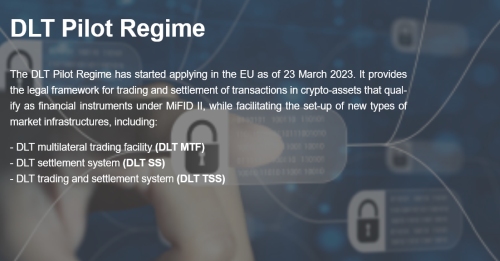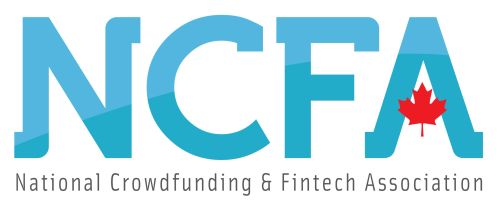Digital Assets | Jun 13, 2024

 Image: ESMA, DLT Pilot Regime
Image: ESMA, DLT Pilot RegimeThe ESMA DLT Pilot Regime: One Year On and Its Future with MiCA
The Distributed Ledger Technology (DLT) Pilot Regime was introduced by the European Securities and Markets Authority (ESMA) on March 23, 2023. This effort provides a regulatory framework for trading and settling transactions using crypto-assets that meet MiFID II‘s definition of financial instruments, with the goal of integrating blockchain technology within the EU’s financial markets. After a year of the regime, instead of publishing it’s annual update report, ESMA has released a 4 page letter outlining difficulties and recommendations that must be taken to ensure success.
Slow Traction
The adoption of the DLT Pilot Regime has been slower than expected as of April 2024. Four official applications have been filed, according to ESMA, and the corresponding National Competent Authorities (NCAs) are presently reviewing them. Eight additional applications are anticipated throughout the year as well. One major explanation for the regime’s sluggish adoption has been attributed to its novelty.
- Creative Approaches to Cash Settlement -> Cash settlement procedures are more difficult without central bank digital currencies (CBDCs). While tokenized commercial bank money or e-money tokens can be used by DLT market infrastructures, applicants have found it challenging to locate appropriate cash leg providers due to regulatory timing mismatches.
See: Central Securities Depositories (CSDs) due to technological and operational complexities.
Other Issues Not Covered in the Implementation Update
ESMA has acknowledged concerns raised by industry stakeholders, particularly those with substantial financial market infrastructure. To make sure their investments pay off, some larger players prefer to develop infrastructure based on “real and sound regulations”.
- Reduce Barriers to Entry –> Innovative initiatives may not be able to participate in the DLT Pilot Regime if technology-driven players find it difficult to get financial institution licenses. Collaborations with financial organizations that currently hold licenses or changes to the law to lower entrance barriers may be beneficial.
See: UK Digital Securities Sandbox: A Guide and Implications
- Interoperability –> Since DLT platforms frequently run in silos, it can be challenging to share data and communicate across several platforms. Improving compatibility is essential to the development of DLT-based financial markets.
- Standardization –> Effective markets and legal frameworks depend on the standardization of token standards and the data models that underpin them. The current state of technology is complicated by the fragmentation of on- and off-chain capabilities and token standards.
ESMA’s Recommendations for Improvement
- Commit to extend the DLT Pilot Regime until at least 2026 in order to reassure market players.
- To increase uptake, provide precise instructions on cash settlement options, custody laws, interoperability, and other crucial matters.
- Maintain strong collaboration with NCAs in reviewing applications and providing yearly reports on the implementation of the regime.
The Need for the ESMA DLT Pilot Regime in the Context of MiCA
Some might argue that the DLT Pilot Regime is no longer necessary now that MiCA Regulation is now in effect. However, in the regulatory landscape of the EU, both play different but complementary roles.
Distinct Objectives and Scopes
In order to ensure consumer protection and market integrity throughout the EU, the MiCA Regulation establishes consistent rules for issuers and service providers. It also provides a complete regulatory framework for crypto-assets that are not considered financial instruments under MiFID II.
See: Christine Lagarde Advocates for a European SEC
The purpose of the ESMA DLT Pilot Regime is to facilitate the integration and experimentation of DLT in traditional financial markets by focusing specifically on financial instruments traded on DLT platforms. The regime provides market participants a controlled environment (regulatory sandbox) in which to test novel DLT technologies.
Complementary Innovation and Regulatory Synergy
MiCA ensures regulatory oversight over a broad range of digital assets by addressing the market for crypto-assets, including those that are not regarded as financial instruments. The goal of the DLT Pilot Regime is to incorporate DLT into the established financial market infrastructure.
By establishing clear guidelines and safeguards, MiCA creates a stable regulatory environment that promotes innovation in the larger crypto-asset market. By providing financial institutions with a sandbox environment to test and improve DLT applications for trading and settlement, the DLT Pilot Regime fosters technical developments within a regulated framework.
See: Balancing Fintech Innovation and Regulation
The DLT Pilot Regime investigates creative DLT-based settlement methods, which can then be included into more comprehensive regulatory frameworks such as MiCA. MiCA establishes guidelines for the custody of crypto-assets. Both programs have a strong emphasis on protecting investors, with the DLT Pilot Regime providing security within financial market infrastructures and MiCA concentrating on consumer safety in the larger crypto market.
Conclusion
It’s imperative for market players and regulatory agencies to keep working together in order to fully implement the DLT Pilot Regime. Targeted modifications and ongoing cooperation between the public and commercial sectors are essential.

 The National Crowdfunding & Fintech Association (NCFA Canada) is a financial innovation ecosystem that provides education, market intelligence, industry stewardship, networking and funding opportunities and services to thousands of community members and works closely with industry, government, partners and affiliates to create a vibrant and innovative fintech and funding industry in Canada. Decentralized and distributed, NCFA is engaged with global stakeholders and helps incubate projects and investment in fintech, alternative finance, crowdfunding, peer-to-peer finance, payments, digital assets and tokens, artificial intelligence, blockchain, cryptocurrency, regtech, and insurtech sectors. Join Canada’s Fintech & Funding Community today FREE! Or become a contributing member and get perks. For more information, please visit: www.ncfacanada.org
The National Crowdfunding & Fintech Association (NCFA Canada) is a financial innovation ecosystem that provides education, market intelligence, industry stewardship, networking and funding opportunities and services to thousands of community members and works closely with industry, government, partners and affiliates to create a vibrant and innovative fintech and funding industry in Canada. Decentralized and distributed, NCFA is engaged with global stakeholders and helps incubate projects and investment in fintech, alternative finance, crowdfunding, peer-to-peer finance, payments, digital assets and tokens, artificial intelligence, blockchain, cryptocurrency, regtech, and insurtech sectors. Join Canada’s Fintech & Funding Community today FREE! Or become a contributing member and get perks. For more information, please visit: www.ncfacanada.org
Related Posts
- SEO Powered Content & PR Distribution. Get Amplified Today.
- PlatoData.Network Vertical Generative Ai. Empower Yourself. Access Here.
- PlatoAiStream. Web3 Intelligence. Knowledge Amplified. Access Here.
- PlatoESG. Carbon, CleanTech, Energy, Environment, Solar, Waste Management. Access Here.
- PlatoHealth. Biotech and Clinical Trials Intelligence. Access Here.
- Source: https://ncfacanada.org/esmas-dlt-pilot-reports-slow-uptake-1-year-on/



